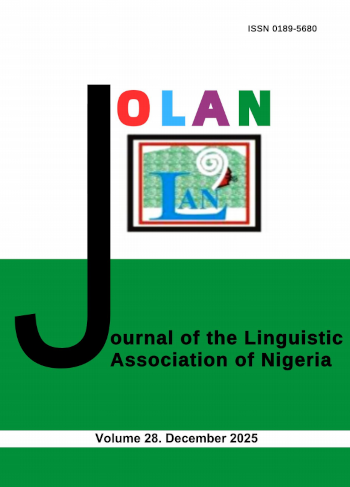Roots in Lexicalism and Non Lexicalism: Examples from Hausa
Keywords:
Hausa, Roots, Lexicalism, Non lexicalismAbstract
Lexicalism and Non lexicalism are two main counterpart approaches to morphology within generative grammar. In lexicalism approach, the grammar is divided into two components viz: Lexicon component and syntactic component. While, non-lexicalism which here is ‘Distributed Morphology’, contains only single generative engine ‘syntax’. In Distributed Morphology, ‘generative lexicon’ was rejected and distributed into three lists viz: (a) Morphemes (b) Vocabulary (c) Encyclopedia. However, these approaches view ‘roots’ differently. In lexicalism, ‘roots’ themselves belong to lexical categories such as noun, verb, adjective and adverb. But to non lexicalism ‘Distributed Morphology’, ‘roots’ are a-categorial and no syntactico-semantic features, neither decomposition (Embick, 2015). Roots can only be assigned to categories after merging with category defining heads or categorizers. And even among Distributed Morphology experts, some contended that roots contained underlying phonological properties, before insertion (Embick, 2015). But to others (De Belder 2011, Harley 2014 & Aquaviva 2014) both roots and features are subjected to late insertion mechanism. All these approaches are to be applied and justified by using the data from Hausa Language. The authors of this paper are fluents in Hausa, but most of the data used are derived from secondary sources including published books and journals. Finally, the out-come of this analysis (on roots) supports the non lexicalism ‘Distributed Morphology’ approach than lexicalism approach.
References
Abubakar, A. (2001). An Introductory Hausa Morphology. Maiduguri: University of Maiduguri.
Amfani, A.H. (2006). Operation ‘Merge’ and the formation of The Hausa Full Verb. In Language & Economic Reforms in Nigeria. Linguistics Association of Nigeria.
Amfani, A.H. (2007b). Hausa Morphology. In Basic linguistics For Nigerian Languages Teachers (ed), Ore Yusuf. (Page 138-148).
Arad, M. (2003). Locality Constraints On The Interpretation of Roots: The Case of Hebrew Denominal Verbs. Natural Language And Linguistic Theory, 21:737-778. Kluwer Academy Publishers. Netherland.
Arad, M. (2005). Roots And Patterns: Hebrew-Morphosyntax. Netherland: Springer Publishers.
Aronoff, M. (1976). Word Formation in Generative Grammar. London: Massachusets Institute Of Technology.
Aronoff, M. A. Fudeman, K. (2005).What is Morphology? Hong-kong: Blackwell Publishing.
Bauer, L. (1988). Introducing Linguistics Morphology. Edinburgh: Edinburgh University Press.
Chomsky, N. (1970). Remarks On Nomilization. In Jacobs And Rosenbaun, Reading In English Transformational Grammar, Ginn An Company, Waltam. Mass.
Chomsky, N. (2001). Derivation by Phase. in M. Kenstonwicz (ed), Ken Hale: A Life in Language, Cambridge , MA: MIT Press, 1-52.
Crystal, D. (2008). A Dictionary Of Linguistics And Phonetics Sixth Edition. United Kindom: Blackwell Publishing.
De Belder, M. (2011). Roots and affixes: Elimanating Lexical Categories From Syntax. Doctoral Theses, Universiteit Utreicht, Netherlands.
De Belder, M. & Craenenbroeck, J.V. (2011). How To Merge Root. MS.
De Belder, M. & Craenenbroeck, J.V. (2013). On Vocabulary Insertion. MS.
De Belder, M. & Craenenbroeck, J.V. (2014). On Functional Vocabulary Items In Root Positions.MS.
Embick, D. & Noyer, R. (2001). Movement Operations After Syntax. In Linguistic inquiry, Vol. 32, No 4. Pp 555-595. MIT.
Embick, D. & Noyer, R. (2007). Distributed Morphology And Syntax/Morphology Interface. In Oxford Hand Book of Linguistics Interface. Oxford University Press. G. Ramchand And C.Reiss (eds).
Embick, D. & Marantz, A. (2008). Architecture and Blocking. Linguistics Inquiry, VOL.38, N0 1.pp 1-53. MIT.
Embick, D. (2008). Variation and Morphosyntactic Theory: Competition Fractioned. In Language and Linguistic Analysis Compass 2/1.pp 59-78.
Embick, D. (2015). The Morpheme: A Theoretical Introduction. University Of Pennsylvania (Final Version).
Fagge, U.U. (2004). An Introduction To Hausa Morphology. Kano:Gidan Dabino Publisher.
Guevara , E, & Scalise, S. (2005). The Lexicalist Approach To Word-formation And The Notion Of The Lexicon. In P. Stekever andR. Lieber (eds) Handbook Of Word-formation , Amsterdam Springer.
Halle, M. (1973). Prolegomena To A Theory Of Word Formation. Linguistic Inquiry, 4, 3-16.
Halle, M. (1990). An Approach To Morphology. Preceedings Of The North East Linguistics Society . 20, VOL 1, 150-84. Anhertst: GLSA University Of Massachussets, Amherts.
Halle, M. & A. Marantz (1993). Distributed Morphology and The Pieces of Inflection. In: K. Hale & S. J. Keyser (eds), The View From Building 20: Essays in Linguistics in honor of Sylvain Bromberger. Cambridge, MA MIT Press.
Harley, H. (2014). On The Identity Of Roots. Theoretical Linguistics 40:225-276.
Haugen, J. D. & Siddiqi, D. (2013). Roots And Derivation. Linguistic Inquiry 44-3.pp 493-517.
Lieber, R. (1980). On the Organization Of Lexicon. Ph.D. Dissertation. MIT.
Marantz, A. (1997). No Escape From Syntax: Don’t Try Morphological Analysis In The Privacy Of Your Own Lexicon, in A. Dimitriadsdis et al.(eds) , U. Penn. Working Papers in Linguistics, 4.2, pp 201-225.
Marantz, A. (2013). No escape from morphemes in morphological processing. In Language and Cognitive Process, Vol 28, N0 7.pp 905-906.
Muhammad, I.A. (2016). Affixation in Generative Morphology: Evidence From Hausa. In Multi-Disciplinary Approaches To The Study Of African Linguistics: A Festschrift For Ahmed H. Amfani. pp 109-127.
Muhammad, I.A. (2016). Distributed Morphology Based-Analysis of Gender and Number In Hausa. Paper Presented at 29 Annual Conference, Linguistic Association of Nigeria. University of Jos.
Noyer, R. 2006. Distributed Morphology. In: Keith Brown, (Editor-in-Chief) Encyclopedia of Language & Linguistics, Second Edition, Volume 3, pp. 734-737. Oxford: Elsevier.
Parsons, F.W. (1960). The Verbal Systems In Hausa: Forms, Function and Grades. Afrika and Ubersee Band XLIV/1: 1-36.
Puigdollers, C.R. (2013). Lexicalization By Phase: The Role Of Preposition In Argument Structure And Its CrossLinguistic Variation. Doctoral Dissertation, Univarsitat Autonoma de Barcelona.
Scalise, S. 1986. Generative Morphology. Foris publications: Dordrecht-Holland.
Syzymanek, B. (1988). Categories And Categorization in Morphology. Lubelskiego Lublin: Katolickiego Uniwerstetu.
Zwicky, A.M., & Spencer, A. (eds). (2001). Hand Book of Morphology. England: Blackwell Publishing.














